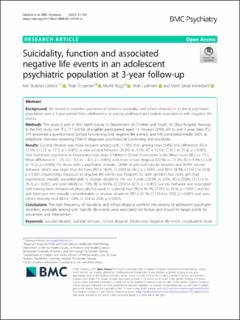| dc.description.abstract | Background
We aimed to examine psychosocial function, suicidality and school dropout in a clinical psychiatric population over a 3-year period from adolescence to young adulthood and explore associations with negative life events.
Methods
This study is part of the Health Survey in Department of Children and Youth, St. Olavs hospital, Norway. In the first study visit (T1), 717 (43.5% of eligible) participated, aged 13–18 years (2009–2011), and 3 years later (T2), 570 answered a questionnaire (school functioning and negative life events), and 549 completed Kiddie SADS as telephone interview assessing DSM-IV diagnoses, psychosocial functioning and suicidality.
Results
Suicidal ideation was more frequent among girls (17.9%) than among boys (5.4%) (risk difference; RD = 12.5%, CI (7.2 to 17.7), p < 0.001), as was suicidal behavior (25.0% vs. 9.5%, RD = 15.5%, CI (9.2 to 21.4), p < 0.001). Girls had lower psychosocial functioning than boys (Children’s Global Assessment Scale; Mean score 68.2 vs. 75.2, Mean difference = − 7.0, CI (− 9.4 to − 4.7), p < 0.001), and more school dropout (22.5% vs. 13.2%, RD = 9.3%, CI (2.8 to 15.5), p = 0.006). For those with a psychiatric disorder, 24.8% of girls had suicidal ideation and 30.0% suicidal behavior, which was larger than for boys (RD = 18.0%, CI (10.8 to 24.7), p < 0.001, and RD = 18.3%, CI (10.2 to 25.8), p < 0.001, respectively). Exposure to negative life events was frequent for both genders, but more girls had experienced sexually uncomfortable or abusive situations, the last 3 years (23.5% vs. 2.9%, RD = 20.6%, CI (15.4 to 25.7), p < 0.001), and ever (44.4% vs. 7.9%, RD = 36.5%, CI (29.9 to 42.7), p < 0.001). Suicidal behavior was associated with having been threatened, physically harassed or violently hurt (RD = 16.7%, CI (9.5 to 23.9), p < 0.001), and for girls been put into sexually uncomfortable or abusive situations (RD = 20.1%, CI (10.4 to 29.9), p < 0.001) and seen others violently hurt (RD = 14.6%, CI (3.4 to 25.8), p = 0.011).
Conclusions
The high frequency of suicidality and school dropout confirms the severity of adolescent psychiatric disorders, especially among girls. Specific life events were associated risk factors and should be target points for prevention and intervention. | en_US |

